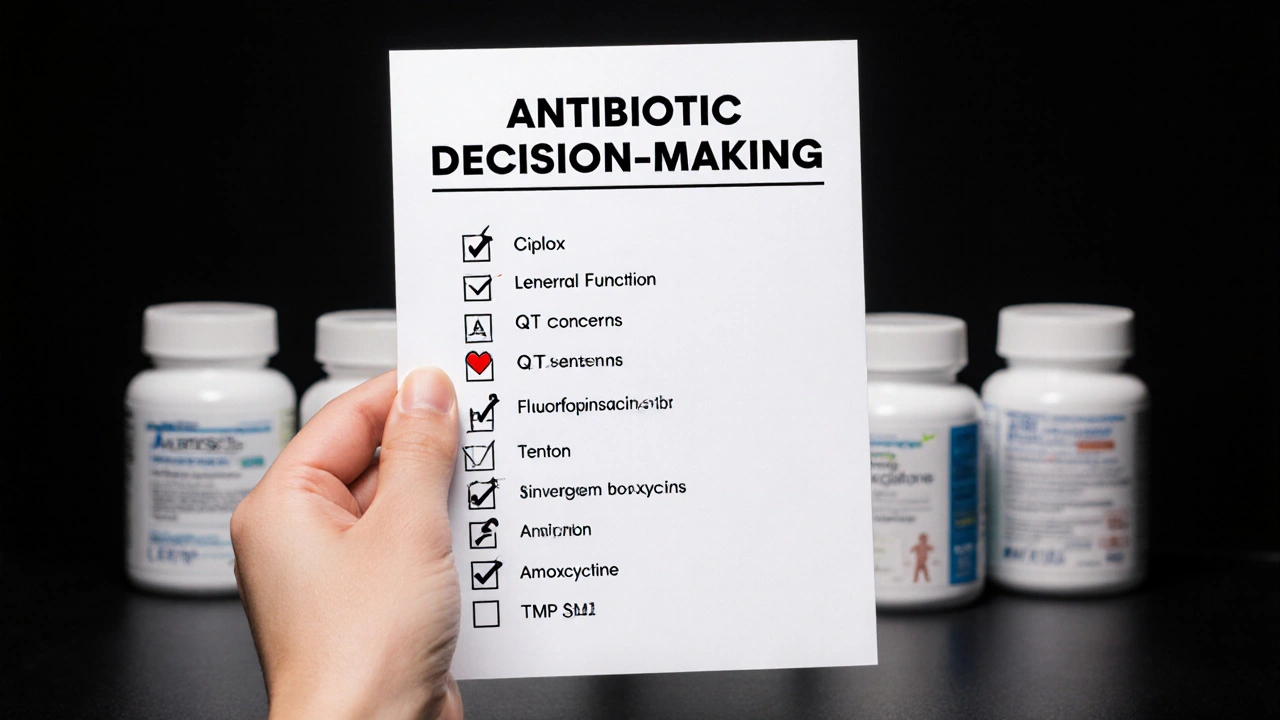Ciplox vs Antibiotic Alternatives Comparison Tool
Spectrum: Coverage against Gram-positive and Gram-negative bacteria
Indications: Common infections treated
Side Effects: Common adverse reactions
Dosage: Typical adult dosing regimen
Contraindications: Conditions where the drug should not be used
| Attribute | Ciprofloxacin (Ciplox) | Levofloxacin | Azithromycin | Amoxicillin | Doxycycline | TMP-SMX |
|---|---|---|---|---|---|---|
| Spectrum (Gram-) | Excellent Gram-negative, decent Gram-positive | Broad, slightly better atypical coverage | Strong atypical, weak Gram-negative | Good Gram-positive, limited Gram-negative | Broad, good for intracellular organisms | Good Gram-negative, moderate Gram-positive |
| Typical Indications | UTIs, GI infections, skin/soft-tissue, bone | CAP, sinusitis, skin infections | Community pneumonia, STIs, bronchitis | Otitis media, sinusitis, strep throat | Rickettsial disease, acne, Lyme disease | UTIs, Pneumocystis prophylaxis, skin |
| Dosage (Adult) | 500 mg PO q12h (or 750 mg q12h for severe) | 500–750 mg PO q24h | 500 mg PO q24h (5-day course) | 500 mg PO q8h | 100 mg PO q12h | 800 mg PO q12h |
| Common Side Effects | Nausea Diarrhea Photosensitivity Tendon risk | GI upset QT prolongation Tendon risk | Abdominal pain Mild liver enzyme rise | Rash Mild GI upset | Photosensitivity Esophagitis | Rash Hyperkalemia Renal impact |
| Major Contraindications | Pregnancy, children | Pregnancy, children | Hypersensitivity to macrolides | Allergy to penicillins | Pregnancy, children | G6PD deficiency, renal failure |
- Ciprofloxacin offers excellent coverage for Gram-negative organisms and UTIs, but carries higher risk of tendon and cartilage issues.
- Levofloxacin provides a similar spectrum with simpler once-daily dosing, yet shares the same fluoroquinolone safety concerns.
- Azithromycin is a macrolide that targets atypical pathogens and is gentler on tendons, but lacks strong Gram-negative activity.
- Amoxicillin and doxycycline are first-line for many common infections, offering lower cost and fewer serious side effects.
- Choosing the right drug depends on infection type, patient age, kidney function, and local resistance patterns.
When a bacterial infection strikes, the first question is often “Which antibiotic will work best?” Ciplox vs alternatives is a common search because ciprofloxacin (sold as Ciplox in many markets) sits in a powerful but sometimes controversial drug class. This article breaks down how ciprofloxacin stacks up against the most frequently used alternatives, so you can see where it shines, where it falls short, and what factors matter when you or your clinician choose a treatment.
Quick Takeaways
- Ciprofloxacin offers excellent coverage for Gram‑negative organisms and urinary‑tract infections, but it carries higher risk of tendon and cartilage issues.
- Levofloxacin provides a similar spectrum with a simpler once‑daily dosing, yet shares the same fluoroquinolone safety concerns.
- Azithromycin is a macrolide that targets atypical pathogens and is gentler on tendons, but it lacks strong Gram‑negative activity.
- Amoxicillin and doxycycline are first‑line for many common infections, offering lower cost and fewer serious side effects.
- Choosing the right drug depends on infection type, patient age, kidney function, and local resistance patterns.
What Is Ciplox (Ciprofloxacin)?
Ciprofloxacin (Ciplox) is a broad‑spectrum fluoroquinolone antibiotic first approved in 1987. It works by inhibiting bacterial DNA gyrase and topoisomeraseIV, enzymes essential for DNA replication. This mechanism makes it especially potent against Gram‑negative bacteria like Escherichia coli and Pseudomonas aeruginosa, while still covering many Gram‑positive organisms.
How Ciprofloxacin Works
By binding to the DNA‑gyrase complex, ciprofloxacin prevents the supercoiling necessary for bacterial chromosome segregation. The result is bacterial cell death, classifying it as a bactericidal agent. Because it targets a process not present in human cells, the drug has a wide therapeutic window-but the same mechanism can affect human connective tissue, explaining its tendon‑rupture warning.
Common Alternatives to Ciprofloxacin
Below are the most frequently considered substitutes, each with its own strengths and limitations.
- Levofloxacin: Another fluoroquinolone, slightly broader against atypical bacteria and often used for community‑acquired pneumonia.
- Azithromycin: A macrolide that excels against atypical pathogens (e.g., Mycoplasma) and is generally gentler on tendons.
- Amoxicillin: A beta‑lactam penicillin widely used for ear, sinus, and throat infections; low cost and well‑tolerated.
- Doxycycline: A tetracycline effective for a range of respiratory and tick‑borne diseases, with anti‑inflammatory benefits.
- Trimethoprim‑sulfamethoxazole (TMP‑SMX): A sulfonamide combo useful for urinary‑tract infections and some skin infections, but with a risk of hypersensitivity.

Side‑Effect Profile Comparison
Side‑effects are a key driver in antibiotic selection. Here’s how the drugs stack up:
- Ciprofloxacin: Nausea, diarrhea, photosensitivity, and rare but serious tendon rupture or cartilage damage-especially in patients over 60 or on steroids.
- Levofloxacin: Similar GI upset and tendon risk; also can cause QT‑interval prolongation.
- Azithromycin: Generally mild-abdominal pain, transient hearing changes; fewer tendon concerns but can affect heart rhythm in high doses.
- Amoxicillin: Low‑grade rash, diarrhea; severe allergic reactions are uncommon but possible.
- Doxycycline: Photosensitivity, esophageal irritation, and rare intracranial hypertension.
- TMP‑SMX: Rash, hyperkalemia, and potential kidney issues; contraindicated in patients with G6PD deficiency.
Head‑to‑Head Comparison Table
| Attribute | Ciprofloxacin (Ciplox) | Levofloxacin | Azithromycin | Amoxicillin | Doxycycline | Trimethoprim‑SMX |
|---|---|---|---|---|---|---|
| Spectrum (Gram‑) | Excellent Gram‑negative, decent Gram‑positive | Broad, slightly better atypical coverage | Strong atypical, weak Gram‑negative | Good Gram‑positive, limited Gram‑negative | Broad, good for intracellular organisms | Good Gram‑negative, moderate Gram‑positive |
| Typical Indications | UTIs, GI infections, skin/soft‑tissue, bone | CAP, sinusitis, skin infections | Community pneumonia, STIs, bronchitis | Otitis media, sinusitis, strep throat | Rickettsial disease, acne, Lyme disease | UTIs, Pneumocystis prophylaxis, skin |
| Dosage (Adult) | 500mg PO q12h (or 750mg q12h for severe) | 500-750mg PO q24h | 500mg PO q24h (5‑day course) | 500mg PO q8h | 100mg PO q12h | 800mg PO q12h |
| Common Side Effects | Nausea, diarrhea, photosensitivity, tendon risk | GI upset, QT prolongation, tendon risk | Abdominal pain, mild liver enzyme rise | Rash, mild GI upset | Photosensitivity, esophagitis | Rash, hyperkalemia, renal impact |
| Major Contraindications | Pregnancy, children <18, steroid use, QT issues | Pregnancy, QT prolongation, seizure disorders | Severe liver disease, QT prolongation | Penicillin allergy | Pregnancy (first trimester), severe liver disease | G6PD deficiency, severe renal impairment |
| Approx. Cost (NZD) | ~$15 for 14‑day pack | ~$18 for 10‑day pack | ~$12 for 5‑day pack | ~$8 for 7‑day pack | ~$10 for 14‑day pack | ~$9 for 14‑day pack |
Decision‑Making Checklist
Use this quick checklist when you or a clinician decide whether ciprofloxacin is the right pick.
- Identify the likely pathogen. Is it a Gram‑negative rod such as E.coli? If yes, ciprofloxacin or levofloxacin are strong candidates.
- Check patient age and pregnancy status. Fluoroquinolones are contraindicated in children and pregnant women.
- Review cardiac history. If the patient has QT prolongation, avoid ciprofloxacin and azithromycin.
- Consider concurrent steroid therapy. Steroids increase tendon‑rupture risk with fluoroquinolones.
- Look at local antimicrobial‑resistance data. In regions with high fluoroquinolone resistance, a beta‑lactam like amoxicillin may be more effective.
Practical Tips & Common Pitfalls
- Take with plenty of water. This reduces the chance of crystalluria, a rare but serious kidney side‑effect.
- Avoid antacids or supplements containing calcium, magnesium, aluminum, or iron within two hours of the dose. They chelate ciprofloxacin and cut absorption by up to 60%.
- Watch for tendon pain. If you feel sudden soreness in the shoulder, Achilles, or knee, stop the drug and seek medical help immediately.
- Do not use for viral infections. Misusing antibiotics fuels resistance and offers no benefit.
- Complete the full course. Even if symptoms improve, stopping early can select for resistant bacteria.

When Ciprofloxacin Is the Best Choice
If you have a confirmed or highly suspected Gram‑negative urinary‑tract infection, especially with resistant strains, ciprofloxacin’s rapid bactericidal action and excellent tissue penetration make it a top option. It also shines in bone and joint infections where other agents may not achieve therapeutic levels.
When to Reach for an Alternative
For uncomplicated community‑acquired pneumonia, azithromycin or doxycycline often provide adequate coverage with fewer safety concerns. For children with otitis media, amoxicillin remains the first‑line therapy. In patients with a history of tendon injury, a fluoroquinolone should be avoided altogether.
Next Steps & Troubleshooting
If you’re unsure which antibiotic fits your situation, start by consulting a healthcare professional who can order a culture when needed. Should you experience side‑effects like severe diarrhea, rash, or joint pain, stop the medication and seek advice promptly. In cases of suspected resistance, an alternative based on susceptibility testing will avoid treatment failure.
Frequently Asked Questions
Can I take Ciplox if I’m pregnant?
No. Ciprofloxacin is classified as pregnancy‑categoryC/D in many regions because it can affect fetal cartilage development. Pregnant patients should use safer alternatives like amoxicillin or azithromycin when appropriate.
How long does it take for Ciplox to work?
Most patients notice symptom relief within 48-72hours, but the full course (usually 7-14days) should be completed to eradicate the infection completely.
What should I do if I develop tendon pain while on Ciplox?
Stop the medication immediately, avoid strenuous activity, and contact a healthcare provider. Early intervention reduces the risk of a full‑blown tendon rupture.
Is a 5‑day course of Ciplox effective for a urinary infection?
Short courses are being studied, but current guidelines in NewZealand still recommend 7-14days for uncomplicated UTIs to ensure eradication and limit resistance.
Can I take Ciplox with over‑the‑counter antacids?
Avoid taking antacids containing calcium, magnesium, aluminum, or iron within two hours of your ciprofloxacin dose, as they can cut absorption dramatically.


16 Comments
Artie Alex
While perusing the ciprofloxacin versus alternatives matrix, one cannot help but perceive a confluence of pharmacodynamic intricacies intertwined with hematological considerations; the drug's affinity for DNA gyrase and topoisomerase IV exemplifies a mechanistic paradigm that eclipses many beta‑lactams in bactericidal potency. Moreover, the spectrum delineated-exemplary Gram‑negative coverage juxtaposed with a moderate Gram‑positive efficacy-renders it a linchpin in the therapeutic armamentarium for complicated urinary tract infections, as well as for certain osteomyelitic sequelae. Yet, the specter of tendonopathy and cartilage degradation, particularly in geriatric cohorts or those concomitantly receiving corticosteroids, mandates a judicious risk‑benefit calculus. The dosage schema, whether the standard 500 mg q12h or the escalated 750 mg q12h in severe phenotypes, must align with renal function metrics to eschew supratherapeutic exposure. One must also contemplate the epidemiological ramifications of fluoroquinolone stewardship, given the propensity for resistance emergence via mutations in the quinolone‑resistance‑determining region (QRDR). In contrast, levofloxacin, though sharing a homologous safety profile, offers a once‑daily regimen that may bolster adherence, yet does not mitigate the QT prolongation risk in susceptible patients. Azithromycin, a macrolide with a predilection for atypical intracellular pathogens, sidesteps the tendon conundrum but suffers from suboptimal Gram‑negative activity, thereby limiting its utility in polymicrobial contexts. Amoxicillin, with its benign adverse event spectrum, remains the first‑line agent for streptococcal pharyngitis, albeit its efficacy wanes against Pseudomonas aeruginosa, a niche where ciprofloxacin thrives. Doxycycline’s intracellular penetration affords coverage of rickettsial organisms, yet its photosensitivity profile warrants patient education. TMP‑SMX, while efficacious for certain cystic fibrosis‑associated infections, bears a contraindication in G6PD deficiency owing to hemolytic risk. Thus, an interdisciplinary consultation encompassing infectious disease specialists, pharmacists, and primary care providers is indispensable to tailor antimicrobial therapy to individual patient idiosyncrasies, infection locus, and local antibiogram data. Ultimately, the decision matrix is a multifactorial algorithmic synthesis of pharmacokinetic parameters, comorbid conditions, and socioeconomic factors influencing drug accessibility.
abigail loterina
Great summary! If you’re unsure which option fits best, think about the infection site and any personal health concerns first. For most everyday infections, starting with amoxicillin or doxycycline can keep things simple and safe.
Roger Cole
Fluoroquinolones aren’t always the answer.
Krishna Garimella
When I look at the data, I see a pattern that goes beyond mere spectra. Ciprofloxacin’s strength lies in its decisive action against pernicious Gram‑negative organisms, but that power can be a double‑edged sword if the patient has risk factors for tendon damage. On the other hand, the elegance of doxycycline’s intracellular reach offers a different kind of versatility, especially for tick‑borne diseases. It’s fascinating how the dosing frequency-twice daily for ciprofloxacin versus once daily for many alternatives-affects adherence, which in turn influences outcomes. The clinician’s role becomes one of balancing these pharmacologic virtues with the patient’s lifestyle, comorbidities, and even local resistance trends. In many cases, a modest drug like amoxicillin can outshine a heavyweight if the pathogen is susceptible, sparing the patient from unnecessary adverse effects. Ultimately, the art of prescribing is a dialogue between science and the individual’s story.
nalina Rajkumar
👍 love the vibe! Just remember, if you’re on ciprofloxacin, wear sunscreen 🌞 and stay hydrated 🚰.
Michael Barrett
Actually-let's be precise-ciprofloxacin's phototoxicity, (i.e., increased UV‑sensitivity), is clinically significant; therefore, clinicians must advise patients on protective measures-sunscreen, hats, sunglasses-especially during summer; however, the risk is dose‑dependent... and not all patients will experience it; still, vigilance is warranted!
Inma Sims
While the comparative table is undoubtedly exhaustive, one must ponder whether the relentless emphasis on "broad‑spectrum" inadvertently fuels antimicrobial resistance-an irony not lost on the discerning clinician.
Gavin Potenza
True, but practicality matters-do you really have time to dissect every nuance when a patient needs immediate relief?
Virat Mishra
Ciprofloxacin is overhyped
Daisy Aguirre
Let's keep it positive! The drug does its job when used correctly, and many patients benefit from its potency-just remember to follow the guidelines.
Natalie Kelly
Totally agree, just watch for side effects.
Tiffany Clarke
Too much jargon.
Mariah Dietzler
info is good but keep it simple
Joery van Druten
Just a note: "contraindications" should be capitalized in the table header for consistency.
Melissa Luisman
And the dosage column needs a clear "mg" unit after each entry-clarity is key.
Akhil Khanna
Thanks everyone for the insights! 🌟 Remember, the best antibiotic choice is the one that fits the patient’s unique context-feel free to share your experiences 😊.